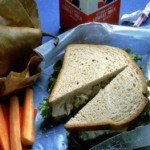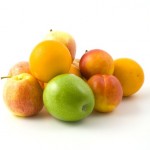Now that school is back in session, the question comes up to “pack lunch?” or to “buy lunch?” It can be a question not only for the kids in the house, but also for the adults who have a limited lunch time or don’t want to eat lunch out. Packing lunch for school or work can be fun, healthy, and creative as well as save some money. Lunch doesn’t have to be boring or the same old kind of lunch every day. I grew up with lunchmeat sandwiches in my school lunch box everyday – very predictable! Now, I find all sorts of foods for a healthy lunch at work, and rarely include a lunchmeat sandwich!
According to Clemson Cooperative Extension’s “Packing Lunches for Work or School” at
http://www.clemson.edu/extension lunch should include at least three of these food groups:
- A protein source
- A source of grains
- Fruit and vegetables
- A calcium source
Stuck in the same old routine and don’t know where to start to find lunch ideas? Start with www.choosemyplate.gov. The My Plate guide to healthy eating has not only suggestions for foods from the various food groups, but the recommended serving sizes for both children and adults. Knowing the correct serving size will help when buying food for lunches.

There are a lot of healthy and creative choices to include in a lunch for you or your student to enjoy. Here are some ideas:
- Protein – lean meat, chili, nuts, peanut butter, canned tuna, or hard-cooked eggs.
- Grains – breads, pasta, whole grain crackers, cereal.
- Fruits and vegetables – apples, plums, bananas, oranges, raw baby carrots, celery, bell pepper sticks, cherry tomatoes, broccoli or cauliflower. Make sure you wash the fruit or vegetable before packing or eating.
- Vegetable juice or 100% fruit juice.
- Single serve fruit cups.
- Salad toppings from the salad bar to top spinach, romaine, or leafy greens.
- Calcium – Skim or 1% milk in single serve bottles, cheese cubes, yogurt, cottage cheese or pudding.
Plan ahead:
Make your own snack packages of fruit, vegetables, whole grain  crackers, nuts, or cheese cubes – ready to grab and go into a lunch bag.
crackers, nuts, or cheese cubes – ready to grab and go into a lunch bag.
Make your own single servings from larger containers of fruit in its own juice or homemade pudding.
Lunch doesn’t have to be boring. Leftovers for lunch? Why not? Pizza, chili, soup, casserole, hamburgers, chicken or other favorites can turn into an easy lunch. If a microwave oven is available, just reheat to 165⁰ F and eat or pack in an insulated container designed to keep food hot. Add leftover chicken to a salad or shred leftover pork, add BBQ sauce and you have a whole new dish!
A word about food safety! Keep packed lunches safe! Follow the suggestions from www.foodsafety.gov. They suggest following the USDA’s steps to food safety: clean, separate, cook, and chill. Keep hands, utensils, and surfaces clean when preparing food. Separate raw and cooked foods. If lunch has perishable foods like cheese, yogurt, eggs, or lunch meat, make sure the food is cold and then pack with at least two cold sources. Bacteria can grow quickly and become unsafe if food is not kept cold. Pack lunches in an insulated lunch box or soft-sided lunch bag. No paper bags for perishable foods! If packing a hot food, first cook the food to the correct temperature and have it hot for packing. Use an insulated container designed to keep hot foods hot. When ready to pack hot food, fill the container with boiling water, let the container stand for a few minutes, empty the water, and then add the piping hot food.
Wash your hands with warm water and soap for 20 seconds if running water is available. If not, pack disposable wipes for wiping hands before and after eating.
Keep cold foods cold and hot foods hot! This applies to bag lunches too!
After lunch is done, discard all leftovers and disposable items. Thoroughly wash any reusable containers. Don’t forget to also wash the insulated lunch box or bag.
Enjoy your lunch and be creative so it is healthy, not boring.

